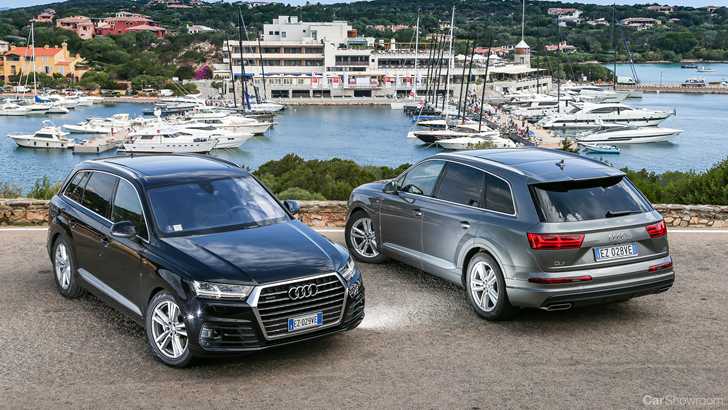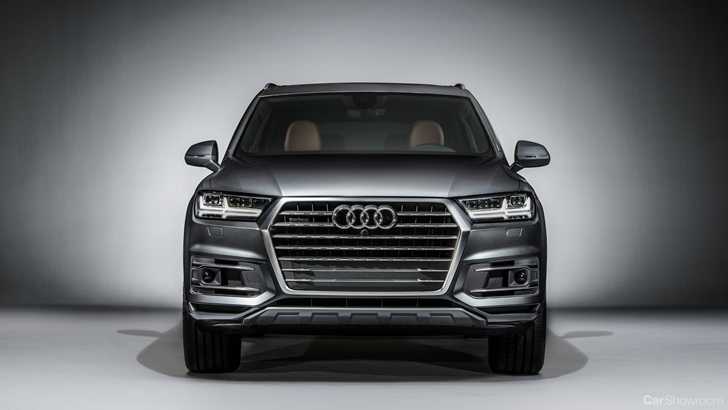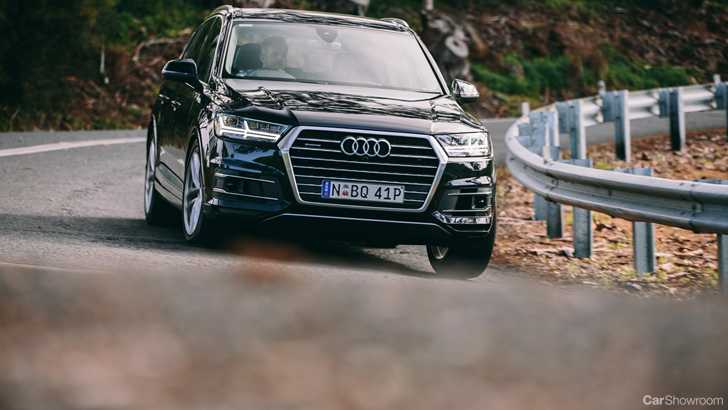Given they are one of the pioneers of all-wheel drive technology in the modern era, Audi’s first brushes with the SUV space took a surprisingly long time to materialise. It started with the first-generation Q7 back in 2005, which was a most commendable if overdue effort, but now that competition has ballooned, its successor will have to try much harder.
Despite the four-rings being uniquely suited to the luxury SUV segment, the Touareg from sibling badge Volkswagen beat the Q7 to that punch, and in essence the Audi was the proper premium product to come out of that development cycle.
As Ingolstadt welcomes their all-new full-size SUV, there’s no shortage of choice for the high-end 7-seater semi-off-roader, but Audi’s second Q7 (called 4M internally) debuted in 2015 with an entirely new arsenal of technologies and advancements to ward off the competition.
Built on the MLB Evo platform that underpins the Audi A4, Bentley Bentayga, and Porsche Cayenne, the new Q7 shares many common strengths with the current crop of Audi products, but some of some weaknesses. But it has a larger responsibility too as it has now been established that, as the model furthest up the food chain, it will set the template for the smaller Q5 and smaller-still Q3.
Clearly, Audi recognises the magnitude of challenges that face the Q7 and has equipped it to the brim with the best know-how they have at their disposal. It’s claimed to be more luxurious, better built, faster, more efficient, and better to drive than the generation it replaces.
Ticking all those boxes, for any type of car, let alone a 7-seater SUV, would be a tall order. Being Audi, they’re not likely to flake on their promised goals, at least not without a fight. But it does raise the question of whether its predecessors’ weaknesses have also been amplified by the pursuit of improving the Q7 as a whole. We’ll find out.
Exterior
“I’ve criticised the Q7’s shy, amorphous design before (strident grille excepted) but its relative subtlety is proving popular,” - CAR
Though outwardly, it conforms to the brand’s most recent design cues, the Q7 has been through an extensive weight loss program. The new architecture itself is lighter as well as more rigid and the body is prided by Audi as being over 300kg lighter than the older model.
While looks are a subjective matter, the Q7’s size will always mean it maintains a certain level of presence on the road. Though, as far as pure aesthetics go, it could be argued that the first-generation model had a certain uniqueness to it that this version substitutes with visual familiarity.
Up close, nobody can doubt its size from justifying the classification as a full-size SUV, but it does bear a significant more resemblance to an Audi estate rather than being immediately identifiable. It’s lines are more pronounced, angular, with echoes of brutalism. Then again, those are traits shared by all Audi’s today.
Engine and Drivetrain
“…not once did we feel the detuned engine lacked the required motivation to get our family going, both around town and on the highway when overtaking slower cars.” - CarAdvice
Only a pair of TDI diesels occupy the local Q7 range, and both are strong performers no matter which you happen to select. Both are 3.0-litre V6 turbodiesels, the same ones that have also found acclaim in the Porsche Panamera and Cayenne.
In the lower state of tune, it will produce 160kW matched to 500Nm. However, choose the higher output version and 200kW becomes available along with 600Nm. Both have been described as silky smooth in their operation to the point of forgetting why petrol engines even exist.
With that much torque, all-wheel drive, and the sheer weight of the thing pressing down on the rubber, the more powerful TDI motor will rocket it to 100km/h in 6.5 seconds (the 160kW version takes 7.3 seconds), which is as quick as a Golf GTI. In a 2.2-tonne SUV, that’s mightily impressive.
The transmission here is an 8-speed automatic that suits the TDI engine’s character very nicely. Shifts are quick and smooth and there’s none of the slow-speed jerkiness one may find in a dual-clutch alternative. Audi claims 5.8-litres/100km is possible in the lower-power TDI while the 200kW version can sip as little as 6.0-litres/100km.
Interior
“Few SUVs challenge a large MPV for back-row space, but the big Audi comes close; its generous wheelbase and capacious roofline translate into sufficient leg and head room for a modest-sized adult.” - Autocar
In raw dimensions, the first-generation Q7 was the more substantial car, however, clever packaging means that the interior in this second-generation version is actually boasts a larger cabin.
There’s no doubting this is a full 7-seater, as even a pair of adults can sit comfortably enough in the rear-most row. Granted, grown-ups are much more suited to the first and second rows, where they’re able to really appreciate how exceptional the interior quality is in addition to offering plenty of leg and headroom.
Leather, of course, is given as standard, but can be upgraded to a higher quality grain. Apart from that, the sheer solidity of the construction stands out as does the level of technology and consideration put into ergonomics and ease of use. It isn’t as flashy as a Mercedes-Benz or quite as sporty feeling as a BMW, but Audi has done a great job at managing expectations here, and upon experiencing the Q7, it’s clear which the really leads the game.
Behind The Wheel
“You’ll also find the pedals, seat and steering wheel are aligned well for a natural seating position, and there’s a well-positioned footrest to the left of the brake.” - WhatCar
On the road, the big Audi is actually a surprise. Threading a vehicle of this sheer girth around a tight urban area may seem like punishment, but thanks to a generally responsive chassis and direct (but vague) steering coupled with good all-round visibility, it’s a far less intimidating object to manoeuvre.
There’s only so much handling you can demand from any car as heavy or generously proportioned as this, but that said the Q7 is very predictable in the way it drives. Body roll is kept to a respectable minimum and the electric steering, as previously mentioned, is reassuringly direct - positives that can’t be applied to its predecessor.
The stand-out attribute with the Q7 on the road, though, is how refined it is. On standard springs, the ride does have a somewhat firm top coat, particularly with the larger 20- or 21-inch wheels, but spec the optional adaptive air suspension allows it to be transformed into a supreme high speed cruiser. All told, there’s very little to complain about.
Safety and Technology
“Some of Audi's safety gear is intrusive. The active steering wants to keep me away from white lines and any sort of gentle cornering path. I loathe this and the steering's over-heavy artificial feel — and deactivate as soon as I can get Audi Australia to talk me through the process.” - CarsGuide
Back in 2015, Euro NCAP were the first to test crash test the second-generation Audi Q7, the technical analysis of which were passed along and formed the basis for ANCAP’s own subsequent 5-star safety rating.
As all Audis go, the Q7 is indeed engineered for safety, both in its construction and insofar as its equipment levels go. A total of 8 airbags are standard and importantly provide curtain protection to all three rows of occupants, while lane keep assist and autonomous emergency braking is provided from the get go, able to operate and prevent collisions at up to 85km/h.
Additionally, an Assistance Package is available as an extra, supplying extra active safety features such as forward collision alert, adaptive cruise control, and Traffic Jam assist. The Q7 impresses on the tech front, especially with the Virtual Cockpit specified, providing a digital instrument cluster than can dynamically display actionable vehicle, navigation, and media info through a 12.3-inch high-resolution display recessed within the binnacle. Right now, it’s the best infotainment package out there. You can choose from two premium audio solutions too; a 19-speaker array from BOSE or a 23-speaker pack from Bang & Olufsen instead of the 10-speaker standard setup.
Verdict
Though it looks big and a potentially clumsy, peer under the skin and the second-generation Q7 reveals itself to be one of the finest large SUVs on sale. Even at this premium level, the engineering and technology brought to bear here is undeniably impressive.
It’s lighter and more nimble that the version it replaces, making it better to drive, but concurrently has been made more luxurious to sit in. While it’s slightly easier to attach these attributes to a smaller car, stretching them over one this ‘substantial’ is most challenging; and one Audi has most definitely conquered.
Auto Express - 4/5 - “The second-generation seven-seater Audi Q7 SUV weighs an amazing 325kg less than the original, and is cheaper to run and better to drive as a result. It’s the most technologically advanced Audi ever,…”
Autocar - 4/5 - “…the Q7 is hugely practical, commendably potent and immaculately mannered, and it comes with a brilliantly constructed cabin – a breathable mix of cathedral-like tranquillity and upper-class imperiousness.”
What Car? - 5/5 - “The outstanding Audi Q7 has a relaxing blend of performance and refinement. It’s also beautifully built, practical and well equipped.”
CAR - “The Q7 is big, but doesn’t feel it. It’s expensive and very well-made, but only the interior shouts about it. It is immensely clever, and while not all of the tech options are genuinely useful or worth their eye-watering prices, one or two might make a huge difference to your long-term enjoyment of your car.”
CarAdvice - 8/10 - “Overall, the Audi Q7 is a fantastic choice for large families seeking a proper seven-seater SUV. It presents the best interior package and ambience of any car in its class, and if you can stretch for a few vital options you’ll be a happy owner for years to come.”
CarsGuide - 4.5/5 - “The bottom line for the Q7 is simple. It's a very, very good car that I'd happily recommend. It's one of the few SUVs that's so good it has to get The Tick, with a big smile.”
































